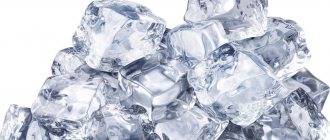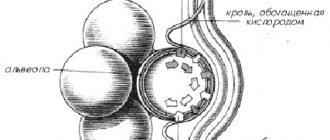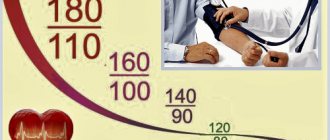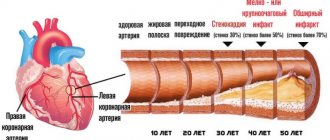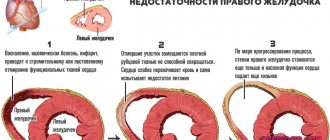Kidney disease is a classic example of how pressure can disrupt the functioning of the kidneys, which in turn can increase blood pressure.
High blood pressure rarely occurs without a reason. In most cases, arterial hypertension is a consequence of progressive damage to the organs responsible for the level of pressure: kidneys, blood vessels, brain, thyroid gland, etc. It is necessary to identify this organ and figure out why it stopped working correctly. Everything becomes more complicated when cause-and-effect relationships are turned upside down.
Kidney pressure - what is it?
There are several main mechanisms for the development of renal hypertension. Firstly, when kidney function is impaired, the body experiences an increase in circulating blood volume and fluid retention. Secondly, excess sodium in the blood increases the sensitivity of the vascular wall to the action of hormones that increase the tone of blood vessels. Thirdly, the impetus for the development of nephrogenic hypertension is given by a low level of prostaglandins and bradykinins (substances that help reduce the tone of blood vessels) in the blood against the background of damage to the kidney tissue.
Often, with renal hypertension, there is an asymmetry of blood pressure in the right and left arms.
All these factors lead to an increase in blood pressure, especially diastolic (lower), which is sometimes called renal pressure for this reason.
Nephrogenic arterial hypertension is divided into three types:
- vasorenal - occurs against the background of vascular damage, often caused by fibromuscular stenosis (more often in women over 30 years of age) or atherosclerotic stenosis of the renal artery (more often in men over 50 years of age);
- parenchymal - develops in diseases characterized by damage to the kidney parenchyma (hydronephrosis, pyelonephritis, glomerulonephritis, kidney tuberculosis, diabetic glomerulosclerosis);
- mixed - appears when both blood vessels and renal tissue are damaged, which is observed with nephroptosis, benign or malignant neoplasms, as well as in the case of a combination of several processes that cause renorenal and parenchymal forms.
In addition, blood pressure increases with prolonged renal colic.
How do kidneys affect blood pressure?
Kidneys and blood pressure are interrelated concepts.
Kidneys and blood pressure are interrelated concepts. The slightest dysfunction of organs has a negative impact on blood flow. Due to the fact that organs are a filter of toxins, decay products, and removal of excess fluid, pathological processes disrupt normal functioning, which means that all harmful substances are not removed from the bloodstream. All these reasons lead to the patient experiencing low or high blood pressure.
Important! High pressure is the result of the accumulation of a large amount of excess fluid in the bloodstream, low pressure is the result of dehydration. Therefore, one of the recommendations for reducing blood pressure is to take diuretics that remove fluid from the body.
Hypertension is caused by damage to the kidney parenchyma or blood vessels, pathologies of the cardiovascular system. The causes of the development of pathological processes can be any kidney disease:
- Nephritis, including glomerulonephritis, lupus nephritis;
- Hydronephrosis;
- Polycystic disease;
- Renal artery dysplasia.
There is also a connection between abnormal pressure and congenital obstructions of the renal tissues - in this case, the patient will only benefit from surgical treatment. The kidneys are an organ directly involved in maintaining normal blood pressure. Producing a number of substances that affect cardiac tone, the filtering organ at the slightest pathology will fail in the direction of increasing or decreasing blood pressure.
Important! Hypertension is a condition in which blood pressure rises, instrument readings range from 140/90 mmHg
Kidney pressure: symptoms
The symptoms of nephrogenic hypertension are in many ways similar to those with high heart pressure (cardiogenic hypertension). Often, with renal hypertension, there is an asymmetry of blood pressure in the right and left arms. In some cases, the pathological condition may not have any clinical signs for a long time.
Nephrogenic arterial hypertension manifests itself in two main groups of symptoms – high blood pressure and kidney damage.
The slow-onset form of the pathology is characterized by an increase in both systolic (upper) and diastolic (lower) pressure. In this case, the patient experiences weakness, fatigue, headache, dizziness, a feeling of lack of air, tachycardia, and chest discomfort.
Increased nephrogenic pressure can be reduced with the help of antihypertensive drugs, however, prolonged symptomatic treatment without eliminating the etiological factor can lead to shrinkage of the kidney.
With rapid-onset nephrogenic hypertension, high diastolic pressure is observed (up to 120 mm Hg and higher, with a norm of 60–80 mm Hg) with normal or slightly elevated systolic pressure. This condition manifests itself through a rapid increase in symptoms: headache localized in the back of the head, nausea, vomiting, blurred vision, general deterioration in well-being, and disorientation.
Renal hypertension is manifested not only by increased blood pressure, but also by lower back pain
Any form is characterized by pain in the lumbar region, acute with fast-flowing nephrogenic hypertension, nagging – with slow-flowing hypertension. Nosebleeds and confusion may also occur.
Symptoms and clinical manifestations
Low lower pressure is always accompanied by manifest clinical manifestations:
- general weakness, feeling of malaise, decreased performance, drowsiness;
- long-term, migraine-type headache;
- pre-fainting;
- impaired visual acuity;
- retrosternal discomfort;
- tachycardia;
- cold profuse sweat;
- feeling of chilliness in fingers and toes, chills;
- anxiety, lack of interest in what is happening around;
- shortness of breath;
- bleeding from the nose;
- pastosity;
- decreased libido;
- dyspepsia;
- weather sensitivity.
Often, low blood pressure leads to orthostatic collapse, when a sudden change in position provokes fainting or fainting as a result of insufficient nutrition and oxygen supply to the brain. In older people, this may be accompanied by an attack of tearfulness, melancholy, and sudden mood swings. A decrease in renal value to critical levels can cause a hypotensive crisis, the early signs of which are:
- migraine;
- loss of orientation in space and time;
- weakness;
- blurred image;
- pathological anxiety;
- arrhythmia with unpleasant sensations in the chest;
- irritability;
- temperature dysregulation.
In fact, this can be interpreted as a transient ischemic attack.
How to determine kidney pressure
Renal hypertension can be suspected by the small difference between systolic and diastolic pressure, in this case it is less than 30 mmHg. Art.
The following diagnostic methods are used:
- Ultrasound of the kidneys;
- Doppler ultrasound angiography;
- excretory urography;
- computed tomography or magnetic resonance imaging of the kidneys.
In addition, laboratory testing of blood and urine is necessary. Renin, catecholamines (differential diagnosis with pheochromocytoma), aldosterone (if adrenal tumors are suspected) are examined. A general urine test may reveal proteinuria, hyposthenuria, and hematuria.
Renal hypertension is characterized by murmurs in the projection of the renal arteries.
Retinal lesions occur more often with nephrogenic than with arterial hypertension of other etiologies. For this reason, patients are necessarily sent for an ophthalmological examination with fundus examination.
Reasons for development
Increased renal pressure is the result of a malfunction of the organ. Among the causes of increased renal pressure:
- renal failure;
- renal artery aneurysm;
- kidney tissue diseases (pyelonephritis, kidney tuberculosis);
- malignant and benign neoplasms in the kidneys.
High renal pressure occurs due to pathologies of the kidneys or their arteries
Separately, high renal blood pressure is distinguished in diabetics, which is caused by changes in the vessels of the organ against the background of increased levels of glucose in the blood.
When measuring blood pressure, both tonometer values should be taken into account. It is believed that the upper pressure is renal, and the lower is cardiac. Thus, with renal hypertension, only the upper or systolic reading may increase, while the lower pressure will remain within normal limits.
Thus, among the reasons for increased renal pressure are any disturbances in the functioning of this organ. The exact cause of the disorder should be identified in order to know how to reduce renal pressure.
How to reduce kidney pressure
Having learned about the diagnosis, patients look for information about what to do and what they can drink with this pathology. It should be borne in mind that you cannot try to treat nephrogenic arterial hypertension on your own - uncontrolled use of pills will most likely only worsen the condition. Why can folk remedies also be used only after consulting a doctor?
Nephrogenic arterial hypertension manifests itself in two main groups of symptoms – high blood pressure and kidney damage.
You can quickly relieve high blood pressure at home using a compress on the feet of table vinegar diluted with water in a 1:1 ratio, but you need to understand that this is only a temporary relief of the condition, this procedure has no therapeutic effect and does not eliminate the need for medical intervention.
Increased nephrogenic pressure can be reduced with the help of antihypertensive drugs, however, prolonged symptomatic treatment without eliminating the etiological factor can lead to shrinkage of the kidney.
What are the causes of low diastolic “bottom” pressure and what to do at home?
Among the health indicators of the human body, data on blood pressure (BP) occupies an important place. Having determined its value, one can draw conclusions about the state of the cardiovascular system. It is known that when the pressure is 110/70, a person is considered healthy.
But what to do if the indicators differ from the generally accepted norm? Is this life-threatening? What measures should be taken if low blood pressure is diagnosed “lower” when the corresponding norm is upper?
Treatment
Treatment of renal pressure is aimed at eliminating the underlying disease that was the cause, so it is dealt with by a nephrologist or urologist.
Drug therapy, depending on the indications, may include anti-inflammatory, antibacterial, and antimycotic drugs. For hydronephrosis, antispasmodic, analgesic drugs, broad-spectrum antibacterial drugs, and diuretics are indicated. Renal tuberculosis requires active anti-tuberculosis therapy. For glomerulonephritis, direct renin inhibitors, angiotensin receptor blockers, and angiotensin-converting enzyme inhibitors are used.
Attention! Photo of shocking content. To view click on
.
In some cases, surgical intervention is necessary: resection or replacement of the renal artery, balloon dilatation. For nephroptosis, nephropexy is usually performed. If only one kidney is affected and conservative treatment is ineffective, partial or complete nephrectomy may be considered. This operation will eliminate hypertension, which otherwise can lead to damage to the second kidney. If both kidneys are significantly damaged, one of them may need to be transplanted.
You can quickly relieve high blood pressure at home using a compress on your feet made from table vinegar diluted with water in a 1:1 ratio.
Hypotension
This disease involves low blood pressure, which is more common among women. The structural features of a woman’s body predispose her to have low blood pressure, as a result of which women tend to experience dizziness, headaches and unreasonable fatigue more often. Hypotension is not considered a separate disease, but rather a condition where a person's blood pressure levels decrease. As a rule, hypotension does not require special treatment; you can eat chocolate or drink coffee. However , low blood pressure may indicate the presence of a disease that needs treatment.
Hypotension has an extremely negative effect on the kidneys. When a person has low blood pressure, the stability of kidney function is disrupted. And if the indicator falls below 75 mm, this becomes a real threat to life.
When the pressure level is below 75 mm, the kidneys stop functioning completely.
The blood that the kidneys are supposed to filter remains uncleaned from excess impurities. During pregnancy, even if a woman can avoid a miscarriage, children are born with complications, since harmful toxins from the mother’s body are not eliminated, but accumulate in the amniotic fluid.
Treatment of an ailment such as low blood pressure involves treating its cause. To prevent low blood pressure from becoming a regular occurrence, you need to see a doctor and get examined. Unfortunately, most people accept low blood pressure as normal and prefer to increase their blood pressure to improve their well-being. However, the effect will be short-lived.
Treatment of renal hypertension
Drug treatment of renal hypertension is aimed at normalizing blood pressure and combating kidney disease. To stabilize the patient's condition, the following drugs are used:
- Thiazide diuretics and adrenaline blockers - indapamide, spironolactone, furosemide. Treatment with these drugs is long-term and carried out continuously. Be sure to follow a special salt-free diet. The degree of renal failure is determined by the size of the glomerular filtration rate. This is a major factor that must be taken into account when prescribing treatment regimens.
- Antihypertensive drugs – enalapril, lisinopril, metoprolol, nifedipine, clonidine. They are used to normalize kidney function. With the development of secondary renal hypertension, Prazorin is considered the most effective. It strengthens and protects the kidneys until their functions are restored.
- Hemodialysis may be needed. In the intervals between its implementation, antihypertensive drugs are used. Also shown are remedies to strengthen the immune system.
Renal arterial hypertension can cause disturbances not only in the functioning of the kidneys, but also in the heart and even in the brain. Therefore, it is important to begin treatment immediately after making an accurate diagnosis.
If drug treatment does not produce the desired results or the patient develops complications in the form of a kidney cyst or other anomalies, surgery or invasive treatment is performed. It is based on balloon angioplasty.
A catheter is inserted into the renal artery and attached to a balloon. When the vessels dilate, the balloon inflates. Thus, the vessels are protected from further narrowing.
Surgical intervention is indicated if renal function is preserved. They resort to it in cases of stenosis or blocked lumens of the arteries. In the future, the patient may need a kidney transplant.
Kidneys and blood pressure relationship
The effect of the kidneys on blood pressure has been studied by many scientists. Back in the 19th century Stolnikov Y.Ya. revealed that if the blood supply to an organ is artificially disrupted, persistent hypertension occurs. Later it was determined that impulses coming from the brain have such an effect on the vessels. Under their influence, the arteries spasm, blood flows more slowly into the organ.
Renin, a hormone of the urinary system, is released reflexively. It combines with a blood plasma protein, globulin, to form hypertensin. The latter has a direct effect on arterial resistance.

